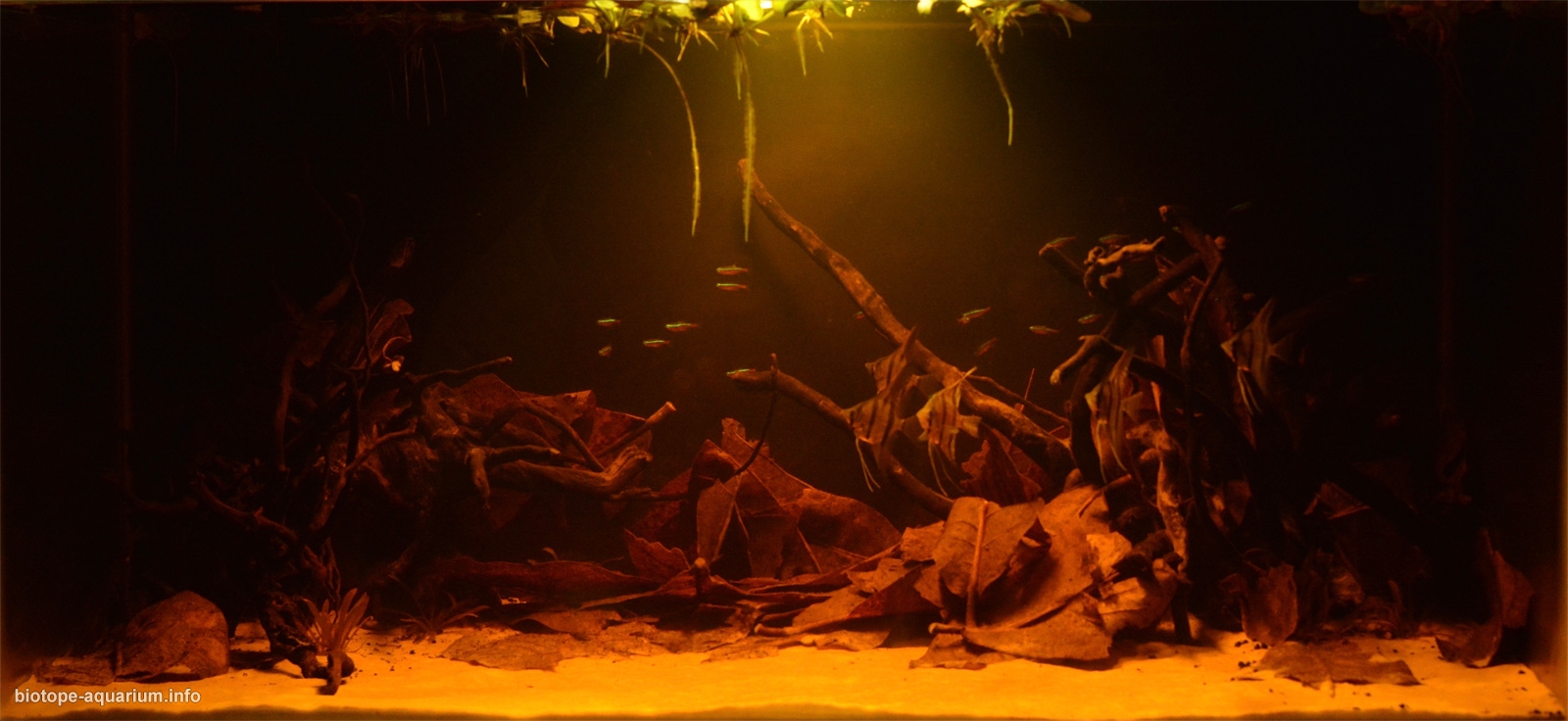Black water stream of the Rio Negro
51st place in Biotope Aquarium Design Contest 2017
![]() India. Stephen Dsouza
India. Stephen Dsouza

Volume: 240 L
Dimensions: 90x60x45 cm
List of fishes: Pteryophyllum Scalare sp. Rio Negro (Sp. manacapuru) – 5, Paracheirodon axelrodi – 30
List of plants: Limnobium laevigatum , Echinodorus tennelus
Description of decorations: JBL white sansibar sand is used to simulate the white fine sand in the biotope. Lots of driftwood similar to the nature biotope was used with Indian almond leaves for the tannins forming the base of leaf litter.
Description of equipment: External Canister Filter Sunsun HW 302, sanrise 18watt LED
Water parameters: Temperature 28 deg C, pH 6
Description of the area surrounding the biotope: The Rio Negro (Black River in Spanish) is the largest tributary of the Amazon river. It is also the largest ‘blackwater’ river in the world. The river can be studied In three sections, ‘the upper, middle and lower course’. The river originates in Colombia, flowing east passing through settlements. The river here in Colombia is known as the Guainia River. After the river flows on it turns south-west where its then referred to as the ‘Rio Negro’. This forms the main upper part of the river. The Middle course continues into Venezuela. The river is fed on both sides with tributaries and grows in size creating river islands, which is a common feature of all rivers in the Amazon basin. Uaupes river is the largest tributary of the Rio Negro, it joins it near Sao Joaquim. The river then continues east as the Lower course. During the wet seasons, this river is responsible for floods in the surrounding areas. The river is a succession of lagoons and channels during this season. Blackwater streams, pools are often seen. The river runs through rainforests, thus collecting numerous fallen branches of trees and lots of leaves that fall. The banks are often deposited with fine sand.
Description of the underwater landscape of the biotope: The blackwater of the river is a result of the tannin-stained, tea coloured water. This is due to the slow moving waters in which decaying vegetation, roots, wood etc result in leeching of acids. The water is transparent and ‘tea coloured’. The base is typically lots of leaf litter, which covers the bottom of fine white sand and sometimes clay.
Description of the parameters of the habitat: The water is very transparent. Tea coloured, tannin-leeched water. The average temperature is always between 27-30 deg. C. The pH is very low and acidic often as low as 4, but an average range of 4.5-6. Water hardness is almost negligible.
List of fishes: Apistogramma Cacatuoides, Apistogramma Agassizzi, Paracheirodon Axelrodi, Hemmigramus Bleheri, Pteryophyllum Scalare sp. Rio Negro (Sp. manacapuru) Symphysodon Discus, Petitella georgiae, Paracheirodon simulans, Dicrossus filamentosus, Corydoras rabauti etc.
List of plants: Echinodorus bleheri, Echinodorus grisebachii, Echinodorus tennelus, Ceratophyllum demersum, Vallisneria sp., Cabomba, Heteranthera, Limnobium laevigatum
Sources of information: https://fish.mongabay.com/biotope_amazon_blackwater.htm, https://rainforests.mongabay.com/0602.htm, http://www.feow.org/ecoregions/details/314, https://fish.mongabay.com/data/ecosystems/Rio%20Negro.htm
